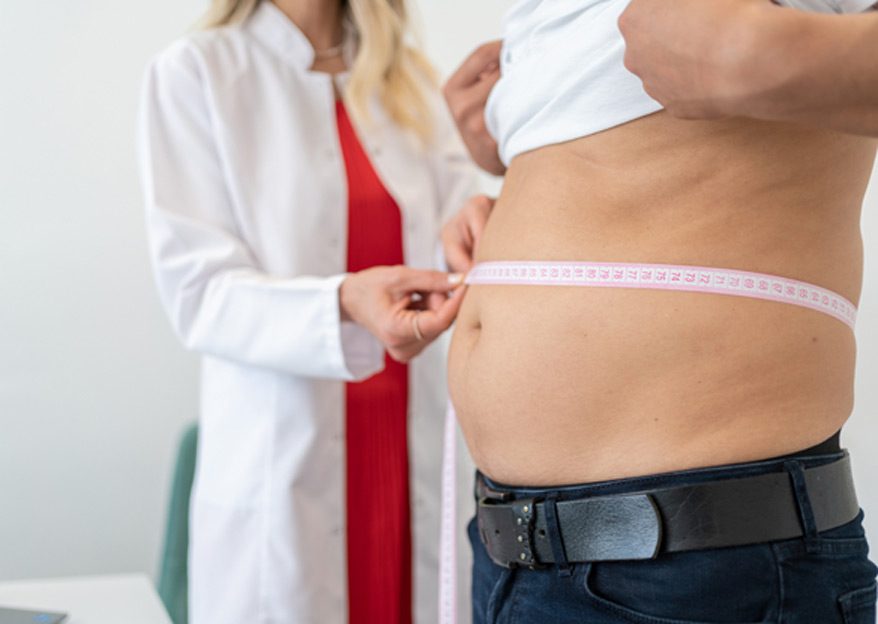Endoscopic sleeve gastroplasty (ESG) is a procedure that utilizes a suturing device to reduce the size of the patient’s stomach and promote weight loss. The patient’s entire stomach is left intact, meaning the organ is not cut or removed. ESG is also referred to as the “scarless sleeve,” “accordion procedure,” or “Apollo Method.”
How Endoscopic Sleeve Gastroplasty Delivers Results
To begin the procedure, the physician will insert an endoscope equipped with a suturing device into the patient’s stomach through the mouth. Then, the doctor will place sutures in a specialized pattern to decrease stomach size. The goals of endoscopic sleeve gastroplasty are to:
- Reduce stomach size by around 70% to reduce its capacity to hold food
- Shorten the length of the stomach between 30% and 50%
The Benefits of Endoscopic Sleeve Gastroplasty
After the procedure, patients may experience improvements in diabetes, hyperlipidemia, hypertension, GERD, and osteoarticular disorders.
Though the procedure has not been shown to directly cause improvements in the following conditions, the weight loss that results from ESG may improve:
- Asthma
- Acid reflux (GERD)
- Mood disorders (anxiety, depression)
- Cognition
- Sleep apnea
- Orthopedic problems
- COPD
- Cardiovascular disease


Who is a Candidate for ESG?
To qualify for endoscopic sleeve gastroplasty, patients should:
- Have a BMI above 30
- Have no previous weight loss surgery
- Not have an eating disorder
- Have no history of ulcers in the stomach or small intestines
- Have blood sugar levels under control, if they’re diabetic
- Not be diagnosed with inflammatory bowel disease
- Have attempted to lose weight through diet and exercise without success
How to Prepare For The Procedure
Before ESG, the patient will need to consume a diet high in protein and low in carbohydrate. They will also need to drink plenty of fluids. Patients will need to stop drinking fluids and consuming food the night before the procedure.
After The Procedure
To support healing of the sutures, patients will need to avoid all carbonated beverages and solid food for the first month. Damage to the sutures may impair weight loss, lead to premature reversal of the procedure, or cause unintended side effects.
About four hours after the procedure patients can begin drinking low-sugar liquids such as water, broth, or iced tea. Patients will need to consume a low-sugar liquid diet for one to two weeks.
At the two week mark, patients can add semi-solid foods into their diet. These foods may include eggs, yogurt, cottage cheese, Jello, canned fruit, and soft fish.
Patients should ask their doctor if they can consume meats, protein powder, potatoes, beans and legumes, fruits, and vegetables.

Foods to avoid include cereals, candy, fibrous vegetables (carrots, peppers, etc), apples, pasta, and bread. Patients should also avoid foods that cause heartburn.
The semi-solid food phase will last for approximately two weeks. Patients should speak to their physician to find out when they can start consuming solid foods.
The Recovery Process
The procedure doesn’t require an extensive recovery period. Patients will be free to go home the same day and may return to work within 24-48 hours after the procedure. Exercising or lifting heavy objects isn’t restricted, either.
FAQs About Endoscopic Sleeve Gastroplasty & The Apollo ESG System
ESG is an endoscopic, incisionless weight loss procedure performed by a doctor, who sutures the stomach with a specialized device called the Apollo ESG™ System to make your stomach smaller.
While you are asleep, a specially-trained doctor passes a suturing device and camera through your mouth. After they reach the inside of your stomach, the doctor sews it into a smaller shape.
The procedure makes the stomach 70-80% smaller. You eat less food so your system absorbs fewer calories. Food stays in the stomach longer, and you feel full longer.
How is ESG different than a laparoscopic gastric sleeve, gastric bypass, or other bariatric surgery?
ESG is performed endoscopically, meaning there are no incisions or scars, and most patients can go home the same day.
The most common side effects are gastrointestinal symptoms such as nausea, abdominal pain, vomiting, constipation, burping, or diarrhea. These symptoms typically resolve within 30-60 days. All procedures have risk. Patients should talk with their doctor and understand all risks before having any procedure.
Apollo ESG™ is for adults with obesity (defined as having a Body Mass Index (BMI) between 30-50 kg/m2) who have not been able to lose weight or maintain weight loss through diet and exercise alone.
Patients who are unable to have an upper endoscopy, are pregnant, are using certain types of blood-thinning medications or have malignant tissue, large hiatal hernia, potentially bleeding gastric lesions, or eating disorders are not eligible for the procedure. Talk to your doctor about whether you are a candidate for ESG.
Patients typically return to work in 2-3 days.
According to a large, randomized clinical study, patients lose an average of 14% of their body weight 12 months after undergoing the ESG procedure. Results will vary by person.
The sutures are made of a durable, permanent material that does not dissolve. However, the sutures can break. In the event the sutures break, you may not feel as full after eating as you did immediately after the procedure. If this happens, another procedure can be done to replace the broken sutures and restore the sleeve.
Over time, scarring and bridging tissue forms to maintain the smaller stomach size and sleeve-like shape. As with weight loss surgeries, the sleeve can stretch over time. In the event the sleeve stretches, you may not feel as full after eating as you did after the procedure. If this happens, a retightening procedure can be performed to place new sutures and restore the sleeve.
In the event that you cannot tolerate the sleeve, your doctor may consider reversal. Reversal soon after the procedure can typically be done by cutting and removing the sutures in your stomach. If more time has passed and scarring has formed, the sleeve could be reversed by a procedure to cut the bridging tissue and removing the sutures, if recommended by your doctor. Like with any procedure, reversal of ESG is associated with risks and should be discussed with your doctor before proceeding.
Healthcare providers work with patients one-on-one to determine payer coverage and financing options.
No, you are typically not required to take nutritional supplements or vitamins following an ESG. Follow your doctor’s instructions on any specialized diet plans during recovery and to maintain a healthy lifestyle
ESG has not been specifically tested or FDA approved for the treatment of weight related health issues like diabetes or hypertension. However, in a clinical study that included some patients with diabetes and hypertension, most of the patients with those conditions lost weight. With the weight loss, they tended to show clinical improvement in those pre-existing conditions


